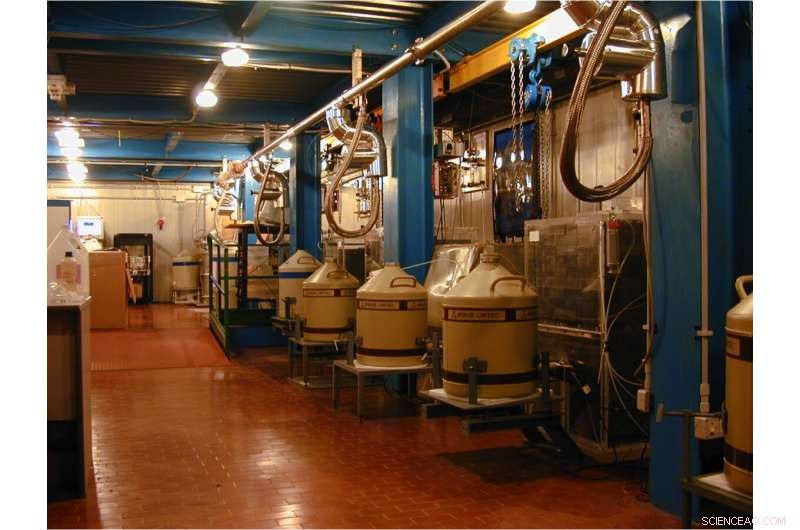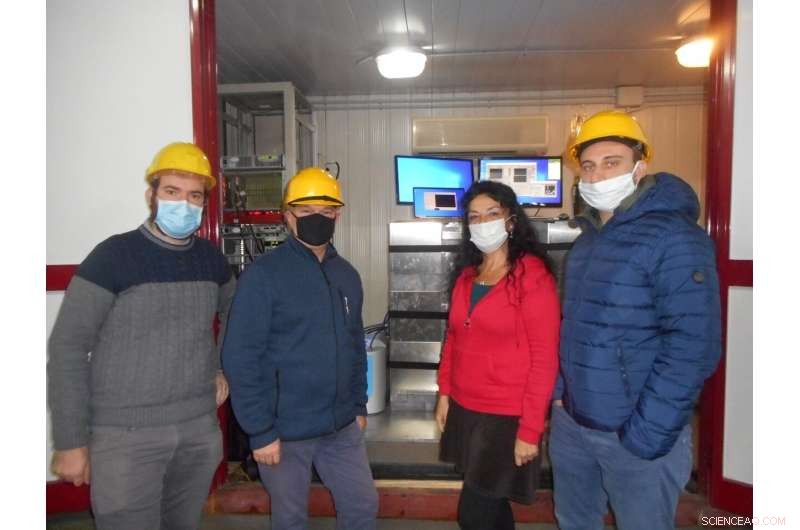
Il laboratorio di bassa radioattività del Gran Sasso. Crediti:Massimiliano De Deo, LNGS-INFN
L'origine della coscienza è uno dei più grandi misteri della scienza. Una soluzione proposta, suggerita per la prima volta dal premio Nobel e dal matematico di Oxford Roger Penrose e dall'anestesista Stuart Hammeroff, dell'Università dell'Arizona, a Tucson, attribuisce la coscienza ai calcoli quantistici nel cervello. Questo a sua volta dipende dall'idea che la gravità potrebbe svolgere un ruolo nel modo in cui gli effetti quantistici scompaiono o "collassano". Ma una serie di esperimenti in un laboratorio nelle profondità delle montagne del Gran Sasso, in Italia, non è riuscita a trovare prove a sostegno di un modello di collasso quantistico correlato alla gravità, minando la fattibilità di questa spiegazione per la coscienza. Il risultato è riportato sulla rivista Physics of Life Reviews .
"Il modo in cui la coscienza sorge nel cervello è un enorme enigma", afferma Catalina Curceanu, membro del think tank di fisica, del Foundational Questions Institute, FQXi, e fisica principale degli esperimenti dell'INFN a Frascati, in Italia. "Ci sono molte idee in competizione, ma pochissime possono essere testate sperimentalmente."
La fisica quantistica ci dice notoriamente che i gatti possono essere vivi e morti allo stesso tempo, almeno in teoria. Eppure in pratica non vediamo mai felini rinchiusi in uno stato di limbo così sfortunato. Una spiegazione popolare del perché no è perché la "funzione d'onda" di un sistema - il suo carattere quantistico che gli consente di trovarsi in due stati contraddittori contemporaneamente - ha maggiori probabilità di "collassare" o essere distrutta se è più massiccia, lasciandolo in uno stato definito stato, morto o vivo, diciamo, ma non entrambi allo stesso tempo. Questo modello di collasso, correlato alla gravità che agisce su oggetti pesanti come i gatti, è stato invocato da Penrose e Hammeroff durante lo sviluppo del loro modello di coscienza, la "teoria Orch OR" (la teoria della riduzione oggettiva orchestrata), negli anni '90.
Calcoli quantistici nel cervello
Curceanu si interessò per la prima volta alla teoria dell'Orch OR quando incontrò Penrose, anche lui membro di FQXi, in una conferenza alcuni anni fa. La coscienza di solito non è associata alle proprietà quantistiche perché gli effetti quantistici sono fragili e difficili da mantenere anche in condizioni altamente controllate e basse temperature in laboratorio. Quindi da tempo si pensava che l'ambiente caldo e umido del cervello sarebbe stato troppo dirompente per consentire agli effetti quantistici di sopravvivere. Ma Penrose ha spiegato che lui e Hammeroff hanno identificato minuscole strutture chiamate microtubuli all'interno dei neuroni nel cervello che potrebbero potenzialmente sostenere effetti quantistici per brevi periodi, giusto il tempo necessario per eseguire calcoli quantistici. La teoria Orch OR attribuisce la coscienza ai calcoli quantistici orchestrati ("Orch") da oscillazioni elettriche in questi microtubuli. "Quello che mi è piaciuto di questa teoria è che in linea di principio è verificabile e ho deciso di cercare prove che potessero aiutarla a confermarla o falsificarla", afferma Curceanu.
"Quello che mi è piaciuto di questa teoria è che in linea di principio è verificabile e ho deciso di cercare prove che potessero aiutarla a confermarla o falsificarla."
Al centro della teoria c'è l'idea che la gravità sia correlata al collasso della funzione d'onda quantistica e che questo collasso sia più veloce nei sistemi con più massa. Questo concetto è stato sviluppato in una serie di modelli da vari fisici negli anni '80. Uno di questi era Lajos Diósi, al Wigner Research Center for Physics e alla Eötvös Loránd University di Budapest, Ungheria, che è stato coautore del nuovo articolo con Curceanu, Maaneli Derakhshani della Rutgers University di New Brunswick, New Jersey, Matthias Laubenstein anche all'INFN, e Kristian Piscicchia del CREF e dell'INFN. Penrose independently approached this idea a few years later and it became the core of his consciousness theory with Hammeroff.
The two theories are often referred to by the umbrella term, the "Diósi-Penrose theory." But behind the joint name there is an important difference, notes Curceanu. Diósi's approach predicts that collapse would be accompanied by the spontaneous emission of a small amount of radiation, just large enough to be detected by cutting edge experiments.

Left to right:Fabrizio Napolitano, Alberto Clozza, Catalina Curceanu, Marco Miliucci -- all from INFN-LNF. Credit:Catalina Curceanu
Andare sottoterra
Curceanu's underground lab is housed within the Gran Sasso National Laboratory, 1.4 km under the Gran Sasso Italian mountains. The lab stands on one side of the 10-km long highway tunnel which crosses the Gran Sasso massif, connecting L'Aquila and Teramo. "The location was chosen because it is basically free from cosmic-ray radiation sources above the ground, that could interfere with the experiment," says Curceanu. The experiment uses an extremely sensitive cylindrical detector, not much bigger than a mug, made from highly pure germanium. It is surrounded by shielding, made of layers of ultra-pure lead and copper, to shelter it from any background radiation coming from the rocks. After running the experiment for two months the team did not measure spontaneous radiation signals, constraining the feasibility of gravity-related collapse. In 2020, the team reported in Nature Physics that their negative result had helped them rule out the simplest version of the Diósi-Penrose model.
In their new paper they have explicitly examined the repercussions of their finding for Penrose and Hammeroff's Orch OR theory of consciousness. After reanalyzing the most plausible scenarios set out by Hammeroff and Penrose, in light of their recent experimental constraints on quantum collapse, they were led to conclude that almost none of the scenarios are plausible. "This is the first experimental investigation of the gravity-related quantum collapse pillar of the Orch OR consciousness model, which we hope will be followed by many others," says Curceanu. "I am very proud of our achievement."
Interdisciplinary characteristics
The experiments and analysis are partially funded by a grant from the Foundational Questions Institute, FQXi. "Without it, it would have not been possible to achieve this outcome," says Curceanu. "It is hard to otherwise get funding for projects such as this, based on its interdisciplinary characteristics."
"It is really exciting to connect what you can do in the laboratory to perhaps the biggest mystery in the universe—consciousness."
But all is not lost for Orch Or, adds Curceanu. "Actually, the real work is just at the beginning." she says. In fact, Penrose's original collapse model, unlike Diósi's, did not predict spontaneous radiation, so has not been ruled out. The new paper also briefly discusses how a gravity-related collapse model might realistically be modified. "Such a revised model, which we are working on within the FQXi financed project, could leave the door open for Orch OR theory," Curceanu says.
Meanwhile the team is preparing to test these refined new collapse models, to further investigate their implications for the Orch OR model. "It is really exciting to connect what you can do in the laboratory to perhaps the biggest mystery in the universe—consciousness," says Curceanu. + Esplora ulteriormente